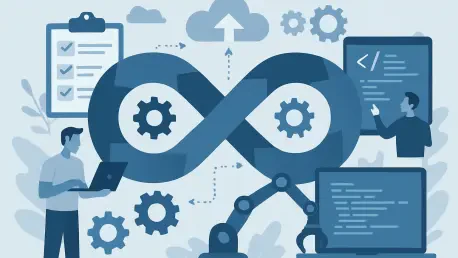The realm of software development and IT operations faces an unprecedented demand for speed and reliability, with studies showing that organizations adopting DevOps practices can achieve deployment frequencies up to 200 times higher than traditional methods. This staggering statistic underscores a pressing challenge: how can teams keep pace with rapid innovation while ensuring system stability? Enter DevOps automation tools, a transformative suite of technologies designed to streamline workflows, bridge collaboration gaps, and accelerate delivery pipelines. This review delves into the core capabilities of these tools, evaluating their features, performance, and impact on modern software ecosystems, offering a detailed perspective on their role in shaping efficient development practices.
Core Principles and Importance of Automation in DevOps
DevOps automation stands as a pivotal mechanism for enhancing collaboration between development and operations teams, focusing on eliminating manual inefficiencies through systematic workflows. At its heart, automation integrates processes like code integration, testing, and deployment into cohesive pipelines, ensuring that repetitive tasks no longer burden engineers. This shift allows teams to prioritize innovation over maintenance, addressing the growing complexity of systems in an era of expansive digital transformation.
The significance of these tools extends beyond mere efficiency, tackling the scalability challenges inherent in large-scale software environments. By codifying operational practices, automation minimizes human error and fosters consistency across diverse infrastructures. Their relevance is evident in industries where rapid delivery and reliability are non-negotiable, positioning them as indispensable assets in achieving a competitive advantage within technology-driven markets.
Detailed Analysis of Key Tool Categories
Continuous Integration and Continuous Delivery (CI/CD) Performance
CI/CD tools form the backbone of DevOps pipelines by automating code building, testing, and deployment, enabling teams to detect issues early and maintain rapid feedback cycles. Tools like Jenkins offer unparalleled flexibility with an open-source framework, while GitLab CI/CD excels in seamless integration with repository management. GitHub Actions further enhances workflow automation, providing developers with intuitive setups for complex pipelines, ensuring velocity without compromising on quality checks.
Performance metrics for CI/CD tools often hinge on pipeline simplicity and scalability, critical for handling increased workloads as teams expand. Integration with version control systems remains a key evaluation criterion, ensuring smooth collaboration across distributed teams. These tools significantly reduce deployment times, often cutting cycles from days to hours, a testament to their ability to sustain development momentum in dynamic environments.
Infrastructure as Code (IaC) and Provisioning Capabilities
IaC tools redefine infrastructure management by treating environments as versioned code, ensuring consistency and traceability across deployments. Terraform leads with a declarative approach and broad provider support, while Pulumi introduces programming language flexibility for nuanced control. AWS CloudFormation caters to specific cloud ecosystems, offering tailored solutions for seamless provisioning within defined parameters.
A standout feature of IaC tools is their modularity, allowing reusable configurations that adapt to multi-cloud setups. Their integration with CI/CD pipelines further streamlines environment setup, eliminating manual configuration errors that plague traditional methods. This capability proves essential for organizations aiming to maintain uniformity across development, staging, and production landscapes.
Configuration Management for System Stability
Configuration management tools play a vital role in maintaining system consistency after initial provisioning, managing updates, and ensuring compliance with defined standards. Ansible shines with agentless, readable playbooks, making it accessible for diverse teams, whereas Chef focuses on compliance-driven automation for regulated industries. Puppet offers centralized control, ideal for large-scale environments requiring strict oversight.
These tools address configuration drift, a common issue in mutable systems, by enforcing standardized states across servers. Their evolving role alongside immutable infrastructure practices highlights a shift toward image-based setups, reducing the need for ongoing adjustments. This adaptability ensures long-term stability, a critical factor for minimizing downtime in production systems.
Infrastructure Orchestration in Distributed Systems
Orchestration tools manage workload deployment and scaling in distributed architectures, a necessity in cloud-native landscapes. Kubernetes dominates with a robust ecosystem, supporting progressive delivery and autoscaling based on real-time metrics. Nomad, on the other hand, provides simplicity for diverse workloads, appealing to teams seeking lightweight alternatives for container management.
Key technical capabilities like health checks and disruption budgets ensure reliability during updates, mitigating risks in live environments. Orchestration tools are indispensable for supporting microservices, enabling seamless scaling as demand fluctuates. Their impact on system uptime and resource optimization underscores their value in high-traffic, distributed setups.
Monitoring and Observability for Actionable Insights
Monitoring and observability tools serve as the feedback loop in DevOps, correlating metrics, logs, and traces to diagnose system behavior. Prometheus excels in metrics collection, particularly with Kubernetes integration, while Grafana offers superior visualization for data interpretation. OpenTelemetry pushes for vendor-agnostic standards, preventing lock-in and enhancing flexibility in tool selection.
Unlike traditional monitoring, modern observability focuses on deeper insights, connecting data points to uncover root causes of incidents. Actionable alerts tied to service level objectives reduce noise, ensuring teams address critical issues without alert fatigue. This precision in feedback mechanisms drives faster mean time to recovery, aligning technical health with business priorities.
Emerging Innovations and Industry Shifts
Recent advancements in DevOps automation reveal a strong tilt toward open-source and cloud-native solutions, with tools like Kubernetes and Terraform setting benchmarks for flexibility and community support. This trend reflects a broader industry preference for tools that adapt to varied environments without proprietary constraints. Their widespread adoption signals a maturing ecosystem where accessibility and customization take precedence.
A notable shift is the move toward declarative, code-based approaches in infrastructure and configuration management, aligning operational practices with software development rigor. This convergence fosters version control and peer review for infrastructure changes, enhancing accountability. Such innovations pave the way for more predictable deployments, reducing risks associated with manual interventions.
Another critical development is the emphasis on observability over conventional monitoring, prioritizing comprehensive system insights over isolated metrics. This evolution enables teams to anticipate issues before they escalate, leveraging correlated data for proactive resolution. As systems grow in complexity, this focus on depth ensures automation remains relevant and effective.
Challenges Impacting Adoption and Integration
Despite their benefits, DevOps automation tools face significant technical hurdles, including integration complexities across disparate systems. Combining tools from different categories often requires custom scripting or middleware, adding overhead to implementation. This challenge is particularly acute for organizations with legacy infrastructures unprepared for modern automation demands.
Organizational barriers also impede progress, with resistance to cultural change posing a persistent obstacle. Teams accustomed to traditional workflows may struggle with the shift to automated, collaborative practices, necessitating comprehensive upskilling initiatives. Addressing this requires a blend of training and change management to align mindsets with technological advancements.
Efforts to mitigate these issues include enhanced documentation and robust community support, alongside vendor solutions offering managed services. These resources aim to lower the learning curve, making tools more accessible to diverse skill levels. Overcoming such challenges remains crucial for maximizing the return on investment in automation technologies.
Final Thoughts and Strategic Recommendations
Looking back, this evaluation of DevOps automation tools highlighted their transformative influence on software delivery, from accelerating pipelines to ensuring system reliability through integrated feedback loops. Each category, whether CI/CD or observability, demonstrated unique strengths in addressing specific workflow pain points. Their collective impact reshaped how teams approach collaboration and scalability in high-stakes environments.
Moving forward, organizations should prioritize strategic tool selection, focusing on integration capabilities to build cohesive pipelines that span the development lifecycle. Exploring hybrid stacks that balance open-source flexibility with enterprise-grade support can address diverse needs effectively. Additionally, investing in team training to bridge cultural and technical gaps will ensure sustainable adoption.
As automation continues to evolve, staying abreast of innovations like AI-driven insights or policy-as-code will be essential for maintaining a competitive edge. Experimenting with emerging tools in controlled environments can uncover new efficiencies, while aligning automation outcomes with business metrics ensures tangible value. These steps will solidify the foundation for resilient, future-ready DevOps practices.









